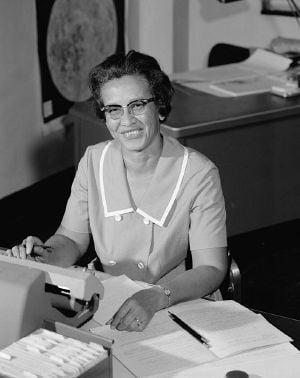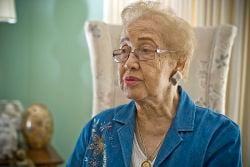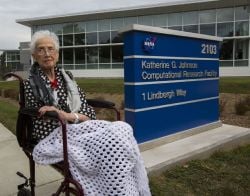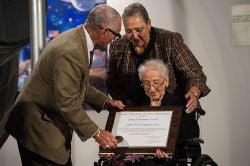Katherine Johnson
| Katherine Johnson | |
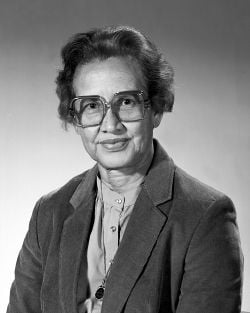 Johnson in 1983
| |
| Born | Creola Katherine Coleman August 26 1918 White Sulphur Springs, West Virginia, U.S. |
|---|---|
| Died | February 24 2020 (aged 101) Newport News, Virginia, U.S. |
| Education | West Virginia State College (BS) |
| Occupation | Mathematician |
| Employer | NACA, NASA 1953–1988 |
| Known for | Calculating the trajectories for many NASA crewed missions |
| Spouse(s) | James Goble (m. 1939; died 1956) Jim Johnson (m. 1959; died 2019) |
| Children | 3 |
Katherine Johnson (born Creola Katherine Coleman; August 26, 1918 – February 24, 2020), also known as Katherine Goble, was an American mathematician whose calculations of orbital mechanics as a NASA employee were critical to the success of the first and subsequent U.S. crewed spaceflights. During her 35-year career at NASA and its predecessor, she earned a reputation for mastering complex manual calculations and helped pioneer the use of computers to perform the tasks. The space agency noted her "historical role as one of the first African-American women to work as a NASA scientist."
Johnson's work included calculating trajectories, launch windows and emergency return paths for Project Mercury spaceflights, including those for astronauts Alan Shepard, the first American in space, and John Glenn, the first American in orbit, and rendezvous paths for the Apollo Lunar Module and command module on flights to the Moon. Her calculations were also essential to the beginning of the Space Shuttle program, and she worked on plans for a mission to Mars.
Her legacy lies not just in her indispensable support of spaceflights, including the successful Apollo 11 first manned flight to the moon, but in breaking barriers of race and gender in the fields of mathematics and science. For this she received the highest honors.
Life
Creola Katherine Coleman was born on August 26, 1918, the youngest of four children, to Joylette and Joshua Colemanin in White Sulphur Springs, West Virginia.[1] Her mother was a teacher and her father was a lumberman, farmer, and handyman, and worked at the Greenbrier Hotel.[2]
Coleman showed strong mathematical abilities from an early age. Because Greenbrier County did not offer public schooling for African-American students past the eighth grade, the Colemans arranged for their children to attend high school in Institute, West Virginia. The family split their time between Institute during the school year and White Sulphur Springs in the summer.[3]
This high school was on the campus of West Virginia State College (WVSC). Johnson was enrolled when she was ten years old:
Fascinated by numbers and smart to boot, for by the time she was 10 years old, she was a high school freshman – a truly amazing feat in an era when school for African-Americans normally stopped at eighth grade for those who could indulge in that luxury. Katherine skipped several grades to graduate from high school at 14 and from college at 18.[4]
After graduating from high school at 14, Johnson enrolled at West Virginia State, a historically black college.[5] As a student, she took every math course offered by the college. Multiple professors mentored her, including the chemist and mathematician Angie Turner King, who had mentored Coleman throughout high school, and W. W. Schieffelin Claytor, the third African-American to receive a Ph.D. in mathematics. Claytor added new mathematics courses just for Katherine. She graduated summa cum laude in 1937, with degrees in mathematics and French, at age 18.[6] She took on a teaching job at a black public school in Marion, Virginia.[5]
In 1939, Katherine married James Francis Goble. She left her teaching job and enrolled in a graduate math program, although she left the program when she became pregnant, choosing to focus on her family.[5] They had three daughters: Constance, Joylette, and Katherine. She was the first African-American woman to attend graduate school at West Virginia University in Morgantown, West Virginia, one of three African-American students, selected to integrate the graduate school after the 1938 United States Supreme Court ruling Missouri ex rel. Gaines v. Canada. The court had ruled that states that provided public higher education to white students also had to provide it to black students, to be satisfied either by establishing black colleges and universities or by admitting black students to previously white-only universities.[2]
In 1953, the Goble family moved to Newport News, Virginia, to pursue a new job opportunity. In 1956, James Goble died of an inoperable brain tumor.
In 1959, Katherine married James A. "Jim" Johnson, a United States Army officer and veteran of the Korean War; the pair were married for 60 years until Jim's death in March 2019 at the age of 93.[7]
She was a member of Carver Memorial Presbyterian Church for 50 years.
Johnson died at a retirement home in Newport News, Virginia on February 24, 2020, at age 101.[8]
Career
Johnson decided on a career as a research mathematician, although this was a difficult field for African Americans and women to enter. The first jobs she found were in teaching. At a family gathering in 1952 a relative mentioned that the National Advisory Committee for Aeronautics (NACA) was hiring mathematicians at the all-black West Area Computing section at the Langley laboratory, headed by fellow West Virginian Dorothy Vaughan.[5] Johnson accepted a job offer from the agency's Guidance and Navigation Department in June 1953 and the family moved to Newport News, Virginia.[1]
According to an oral history archived by the National Visionary Leadership Project:
At first she [Johnson] worked in a pool of women performing math calculations. Katherine has referred to the women in the pool as virtual "computers who wore skirts." Their main job was to read the data from the black boxes of planes and carry out other precise mathematical tasks. Then one day, Katherine (and a colleague) were temporarily assigned to help the all-male flight research team. Katherine's knowledge of analytic geometry helped make quick allies of male bosses and colleagues to the extent that, "they forgot to return me to the pool." While the racial and gender barriers were always there, Katherine says she ignored them. Katherine was assertive, asking to be included in editorial meetings (where no women had gone before). She simply told people she had done the work and that she belonged.[1]
From 1953 to 1958, Johnson worked as a computer,[9] analyzing topics such as gust alleviation for aircraft. Originally assigned to the West Area Computers section supervised by mathematician Dorothy Vaughan, Johnson was reassigned to the Guidance and Control Division of Langley's Flight Research Division. It was staffed by white male engineers.[10] In keeping with state racial segregation laws, and federal workplace segregation introduced under President Woodrow Wilson in the early twentieth century, Johnson and the other African-American women in the computing pool were required to work, eat, and use restrooms that were separate from those of their white peers. Their office was labeled as "Colored Computers." In an interview, Johnson stated that:
[She] didn't feel the segregation at NASA, because everybody there was doing research. You had a mission and you worked on it, and it was important to you to do your job ... and play bridge at lunch. ... I didn't feel any segregation. I knew it was there, but I didn't feel it.[11]
NACA disbanded the colored computing pool in 1958 when the agency was superseded by NASA, which adopted digital computers. Although the installation was desegregated,[10] forms of discrimination were still pervasive. Johnson recalled that era:
We needed to be assertive as women in those days – assertive and aggressive – and the degree to which we had to be that way depended on where you were. I had to be. In the early days of NASA women were not allowed to put their names on the reports – no woman in my division had had her name on a report. I was working with Ted Skopinski and he wanted to leave and go to Houston ... but Henry Pearson, our supervisor – he was not a fan of women – kept pushing him to finish the report we were working on. Finally, Ted told him, "Katherine should finish the report, she's done most of the work anyway." So Ted left Pearson with no choice; I finished the report and my name went on it, and that was the first time a woman in our division had her name on something.[12]
From 1958 until her retirement in 1986, Johnson worked as an aerospace technologist, moving during her career to the Spacecraft Controls Branch. She calculated the trajectory for the May 5, 1961 space flight of Alan Shepard, the first American in space.[13] She also calculated the launch window for his 1961 Mercury mission.[14] She plotted backup navigation charts for astronauts in case of electronic failures.[1] When NASA used electronic computers for the first time to calculate John Glenn's orbit around Earth, officials called on Johnson to verify the computer's numbers; Glenn had asked for her specifically and had refused to fly unless Johnson verified the calculations.[13] Author Margot Lee Shetterly stated, "So the astronaut who became a hero, looked to this black woman in the still-segregated South at the time as one of the key parts of making sure his mission would be a success." She added that, in a time where computing was "women's work" and engineering was left to men, "it really does have to do with us over the course of time sort of not valuing that work that was done by women, however necessary, as much as we might. And it has taken history to get a perspective on that."[15]
Johnson later worked directly with digital computers. Her ability and reputation for accuracy helped to establish confidence in the new technology.[16] In 1961, her work helped to ensure that Alan Shepard's Freedom 7 Mercury capsule would be quickly found after landing, using the accurate trajectory that had been established.[17]
She also helped to calculate the trajectory for the 1969 Apollo 11 flight to the Moon.[13][16] During the Moon landing, Johnson was at a meeting in the Pocono Mountains. She and a few others crowded around a small television screen watching the first steps on the Moon. In 1970, Johnson worked on the Apollo 13 Moon mission. When the mission was aborted, her work on backup procedures and charts helped set a safe path for the crew's return to Earth,[16] creating a one-star observation system that would allow astronauts to determine their location with accuracy. In a 2010 interview, Johnson recalled, "Everybody was concerned about them getting there. We were concerned about them getting back."[17] Later in her career, Johnson worked on the Space Shuttle program, the Earth Resources Satellite,[16] and on plans for a mission to Mars.[18]
Johnson spent her later years encouraging students to enter the fields of science, technology, engineering, and mathematics.[19]
Legacy and honors
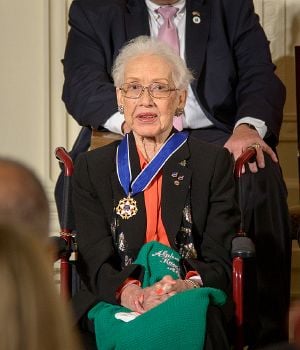
Following her death, Jim Bridenstine, NASA's administrator, described her as "an American hero" and stated that "her pioneering legacy will never be forgotten."[5] "Her calculations proved as critical to the success of the Apollo Moon landing program and the start of the Space Shuttle program, as they did to those first steps on the country's journey into space."[13]
Johnson co-authored 26 scientific papers.[1][20] Her social influence as a pioneer in space science and computing is demonstrated by the honors she received and her status as a role model for a life in science.[20] Johnson was named West Virginia State College Outstanding Alumnus of the Year in 1999. President Barack Obama presented Johnson with the Presidential Medal of Freedom, one of 17 Americans so honored on November 24, 2015. President Obama said at the time, "Katherine G. Johnson refused to be limited by society's expectations of her gender and race while expanding the boundaries of humanity's reach."[8] NASA noted her "historical role as one of the first African-American women to work as a NASA scientist."[21]
On May 5, 2016, a new 40,000-square-foot (3,700 m²) building was named "Katherine G. Johnson Computational Research Facility" and formally dedicated at the agency's Langley Research Center in Hampton, Virginia. The facility officially opened its doors on September 22, 2017. Johnson attended this event, which also marked the 55th anniversary of astronaut Alan Shepard's historic rocket launch and splashdown, a success Johnson helped achieve.[22] At the ceremony, deputy director Lewin said this about Johnson: "Millions of people around the world watched Shepard's flight, but what they didn't know at the time was that the calculations that got him into space and safely home were done by today's guest of honor, Katherine Johnson."[23] During the event, Johnson also received a Silver Snoopy award; often called the astronaut's award, NASA stated it is given to those "who have made outstanding contributions to flight safety and mission success."[24]
In 2016, Johnson was included in the list of "100 Women", BBC's list of 100 influential women worldwide.[25] NASA stated, "Her calculations proved as critical to the success of the Apollo Moon landing program and the start of the Space Shuttle program, as they did to those first steps on the country's journey into space."[13]
The highly acclaimed film Hidden Figures, released in December 2016, was based on the non-fiction book of the same title by Margot Lee Shetterly, which was published earlier that year. It follows Johnson and other female African-American mathematicians (Mary Jackson and Dorothy Vaughan) who worked at NASA. Taraji P. Henson plays Johnson in the film.[26] Appearing alongside Henson at the 89th Academy Awards, Johnson received a standing ovation from the audience.[27] In an earlier interview, Johnson offered the following comment about the movie: "It was well-done. The three leading ladies did an excellent job portraying us."[28]
In August 2018, West Virginia State University established a STEM scholarship in honor of Johnson and erected a life-size statue of her on campus.[29] In 2018, Mattel announced a Barbie doll in the likeness of Johnson, with a NASA identity badge.[30] In 2019, Johnson was announced as one of the members of the inaugural class of Government Executive's "Government Hall of Fame."[31]
Two NASA facilities have been named in honor of Johnson. In addition to honoring her with the Katherine G. Johnson Computational Research Facility in Hampton, Virginia, NASA later renamed the Independent Verification and Validation Facility, in Fairmont, West Virginia, to the Katherine Johnson Independent Verification and Validation Facility on February 22, 2019.[32]
Awards
- NASA Group Achievement Award presented to the Lunar Spacecraft and Operations team – for pioneering work in the field of navigation supporting the spacecraft that orbited and mapped the Moon in preparation for the Apollo program[1]
- 1971, 1980, 1984, 1985, 1986: NASA Langley Research Center Special Achievement award[33]
- 1998, Honorary Doctor of Laws, from SUNY Farmingdale[1]
- 1999, West Virginia State College Outstanding Alumnus of the Year[1]
- 2006, Honorary Doctor of Science by the Capitol College, Laurel, Maryland[1]
- 2010, Honorary Doctorate of Science from Old Dominion University, Norfolk, Virginia[34]
- 2015, NCWIT Pioneer in Tech Award[35]
- 2015, Presidential Medal of Freedom[6]
- 2016, Silver Snoopy award from Leland Melvin[24]
- 2016, Astronomical Society of the Pacific's Arthur B.C. Walker II Award[36]
- 2017, Daughters of the American Revolution (DAR) Medal of Honor[37]
- 2017 Honorary Doctorate from Spelman College[38]
- May 12, 2018, Honorary Doctorate of Science from the College of William and Mary, Williamsburg, Virginia[39]
- April 29, 2019, honorary degree from the University of Johannesburg, South Africa[40]
- November 8, 2019, Congressional Gold Medal[41]
Notes
- ↑ 1.0 1.1 1.2 1.3 1.4 1.5 1.6 1.7 1.8 Katherine Johnson: National Visionary National Visionary Leadership Project. Retrieved March 5, 2020.
- ↑ 2.0 2.1 David Gutman, West Virginian of the Year: Katherine G. Johnson Charleston Gazette-Mail, December 26, 2015. Retrieved March 5, 2020.
- ↑ Dr. Katherine Coleman Goble Johnson, 2017 National Space Grant Distinguished Service Award Retrieved March 5, 2020.
- ↑ Yvette Smith, Katherine Johnson: The Girl Who Loved to Count NASA, November 24, 2015. Retrieved March 5, 2020.
- ↑ 5.0 5.1 5.2 5.3 5.4 Sarah Loff, Katherine Johnson Biography NASA, November 22, 2016. Retrieved March 5, 2020.
- ↑ 6.0 6.1 David Gutman, WV native, NASA mathematician to receive Presidential Medal of Freedom Charleston Gazette-Mail, November 16, 2015. Retrieved March 6, 2020.
- ↑ Obituary: James A. Johnson O.H. Smith & Son Funeral Home, March 13, 2019. Retrieved March 6, 2020.
- ↑ 8.0 8.1 Margalit Fox, Katherine Johnson Dies at 101; Mathematician Broke Barriers at NASA The New York Times, February 25, 2020. Retrieved March 6, 2020.
- ↑ Jim Hodges, She Was a Computer When Computers Wore Skirts NASA, February 24, 2020. Retrieved March 6, 2020.
- ↑ 10.0 10.1 Cara Buckley, On Being a Black Female Math Whiz During the Space Race The New York Times, September 6, 2016. Retrieved March 6, 2020.
- ↑ Katherine Johnson Interview: NASA's Human Computer History vs Hollywood. Retrieved March 6, 2020.
- ↑ Wini Warren, "Katherine Coleman Goble Johnson", in Black Women Scientists in the United States (Indiana University Press, 2000, ISBN 978-0253336033).
- ↑ 13.0 13.1 13.2 13.3 13.4 Yvette Smith, Katherine Johnson: The Girl Who Loved to Count NASA History, November 24, 2015. Retrieved March 5, 2020.
- ↑ A.K. Whitney, The Black Female Mathematicians Who Sent Astronauts to Space Mental Floss, February 1, 2016. Retrieved March 6, 2020.
- ↑ 'Hidden Figures': How Black Women Did The Math That Put Men On The Moon NPR, September 25, 2016. Retrieved March 6, 2020.
- ↑ 16.0 16.1 16.2 16.3 Katherine Johnson Biography (1918–2020) Biography.com, February 24, 2020. Retrieved March 6, 2020.
- ↑ 17.0 17.1 Meghan Bartels and Paulina Cachero, Katherine Johnson, the NASA mathematician who helped put a man on the moon, died at 101. Here's a look back at the hidden figure's remarkable life Business Insider, February 24, 2020. Retrieved March 6, 2020.
- ↑ Jodi Guglielmi, Katherine Johnson, Legendary Mathematician and Inspiration for the Upcoming Film Hidden Figures, Turns 98 People, August 26, 2016. Retrieved March 6, 2020.
- ↑ Mathematics pioneer Katherine Johnson, portrayed in 'Hidden Figures,' dies at 101 The Associated Press, February 24, 2020. Retrieved March 6, 2020.
- ↑ 20.0 20.1 Human computers: Katherine G. Johnson NASA Cultural Resources (CRGIS). Retrieved March 8, 2020.
- ↑ Hidden Figures To Modern Figures: Students See SLS Rocket at Michoud NASA, November 24, 2016. Retrieved March 8, 2020.
- ↑ Karen Northon, NASA Dedicates Facility to Mathematician, Presidential Medal Winner NASA, August 6, 2017. Retrieved March 8, 2020.
- ↑ J.J. O'Connor and E.F. Robertson, Katherine Coleman Goble Johnson School of Mathematics & Statistics University of St Andrews, UK. Retrieved March 8, 2020.
- ↑ 24.0 24.1 Sarah Loff, Katherine Johnson at NASA Langley Research Center NASA History, February 26, 2019. Retrieved March 8, 2020.
- ↑ BBC 100 Women 2016: Who is on the list? BBC News, October 7, 2019. Retrieved March 8, 2020.
- ↑ Sarah Sloat, 'Hidden Figures' Gives NASA Mathematicians Long Overdue Movie Inverse, August 15, 2016. Retrieved March 8, 2020.
- ↑ Taylor Maple, Katherine Johnson, real-life subject of 'Hidden Figures' receives standing ovation at Oscars ABC News, February 26, 2017. Retrieved March 8, 2020.
- ↑ Meet Katherine Johnson, NASA mathematician in 'Hidden Figures' Los Angeles Times, January 9, 2017. Retrieved March 8, 2020.
- ↑ Jack Bailey, West Virginia State University to Honor Katherine Johnson with Statue, Scholarship West Virginia State University, May 31, 2018. Retrieved March 8, 2020.
- ↑ Andi Petrini, Katherine Johnson to be included in Barbie 'Inspiring Women' series Daily Press, March 8, 2018. Retrieved March 8, 2020.
- ↑ Tom Shoop, Inaugural Inductees Into Government Hall of Fame Unveiled Government Executive, August 15, 2019. Retrieved March 8, 2020.
- ↑ Gina Cook, NASA Honors 'Hidden Figure' Katherine Johnson NBC4 Washington, February 22, 2019. Retrieved March 8, 2020.
- ↑ Katherine G. Johnson: Biography The History Makers. Retrieved March 8, 2020.
- ↑ Noell Saunders, MLK Event to Feature 'Hidden Figures' Author Margot Lee Shetterly Old Dominion University, January 4, 2017. Retrieved March 8, 2020.
- ↑ Katherine Johnson National Center for Women & Information Technology, 2015. Retrieved March 8, 2020.
- ↑ Katherine Johnson to receive the ASP's new Arthur B.C. Walker II Award Astronomical Society of the Pacific, August 16, 2016. Retrieved March 8, 2020.
- ↑ 126th Continental Congress Daughters of the American Revolution Convene in Washington, D.C. Daughters of the American Revolution, June 26, 2017. Retrieved March 8, 2020.
- ↑ Honorary Degree Recipients Spelman College. Retrieved March 8, 2020.
- ↑ Trailblazing African-American women to be honored at William & Mary William & Mary, March 23, 2018. Retrieved March 8, 2020.
- ↑ Tanya Farber, Hidden Nasa genius honoured by SA varsity The Times Johannesburg, April 29, 2019. Retrieved March 8, 2020.
- ↑ NASA's 'hidden figures' to be awarded Congressional Gold Medals Collect SPACE, November 8, 2019. Retrieved March 7, 2020.
ReferencesISBN links support NWE through referral fees
- Golemba, Beverly. Human Computers: The Women in Aeronautical Research, unpublished manuscript 1994, NASA Langley Archives. Retrieved March 4, 2020.
- Johnson, Katherine. Reaching for the Moon: The Autobiography of NASA Mathematician Katherine Johnson. Atheneum Books for Young Readers, 2019. ISBN 978-1534440838
- Narins, Brigham. Notable Scientists: From 1900 to the Present. Gale Group, 2001. ISBN 9780787617547
- Shetterly, Margot Lee. Hidden Figures: The American Dream and the Untold Story of the Black Women Mathematicians Who Helped Win the Space Race. William Morrow Paperbacks, 2016. ISBN 978-0062363602
- Warren, Wini. Black Women Scientists in the United States. Indiana University Press, 2000. ISBN 978-0253336033
- Zierdt-Warshaw, Linda, Alan Winkler, and Leonard Bernstein. American Women in Technology: An Encyclopedia. ABC-CLIO, 2000. ISBN 978-1576070727
External links
All links retrieved March 2, 2025.
- Katherine Johnson Biography at NASA
- Katherine Johnson, NASA Mathematician Video produced by Makers: Women Who Make America
- Katherine Johnson: Pioneering NASA mathematician Space.com
- Katherine Johnson, NASA Mathematician And An Inspiration For 'Hidden Figures,' Dies NPR
- National History Day - "Katherine Johnson, A Quiet Triumph in a White Man's World" C-SPAN, June 11, 2019.
- Katherine Coleman Goble Johnson School of Mathematics and Statistics, University of St Andrews, Scotland.
Credits
New World Encyclopedia writers and editors rewrote and completed the Wikipedia article in accordance with New World Encyclopedia standards. This article abides by terms of the Creative Commons CC-by-sa 3.0 License (CC-by-sa), which may be used and disseminated with proper attribution. Credit is due under the terms of this license that can reference both the New World Encyclopedia contributors and the selfless volunteer contributors of the Wikimedia Foundation. To cite this article click here for a list of acceptable citing formats.The history of earlier contributions by wikipedians is accessible to researchers here:
The history of this article since it was imported to New World Encyclopedia:
Note: Some restrictions may apply to use of individual images which are separately licensed.
